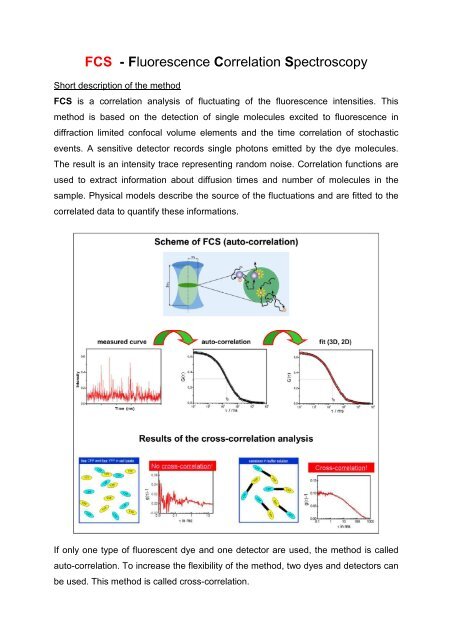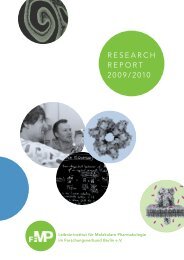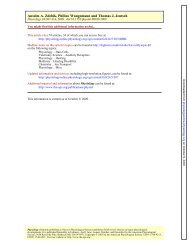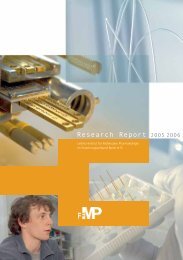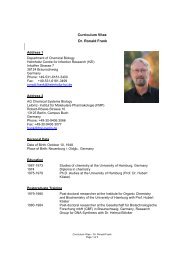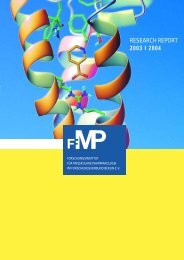FCS - Fluorescence Correlation Spectroscopy - FMP
FCS - Fluorescence Correlation Spectroscopy - FMP
FCS - Fluorescence Correlation Spectroscopy - FMP
You also want an ePaper? Increase the reach of your titles
YUMPU automatically turns print PDFs into web optimized ePapers that Google loves.
<strong>FCS</strong> - <strong>Fluorescence</strong> <strong>Correlation</strong> <strong>Spectroscopy</strong><br />
Short description of the method<br />
<strong>FCS</strong> is a correlation analysis of fluctuating of the fluorescence intensities. This<br />
method is based on the detection of single molecules excited to fluorescence in<br />
diffraction limited confocal volume elements and the time correlation of stochastic<br />
events. A sensitive detector records single photons emitted by the dye molecules.<br />
The result is an intensity trace representing random noise. <strong>Correlation</strong> functions are<br />
used to extract information about diffusion times and number of molecules in the<br />
sample. Physical models describe the source of the fluctuations and are fitted to the<br />
correlated data to quantify these informations.<br />
If only one type of fluorescent dye and one detector are used, the method is called<br />
auto-correlation. To increase the flexibility of the method, two dyes and detectors can<br />
be used. This method is called cross-correlation.
Other common methods to use fluorescence fluctuations to probe molecular<br />
interactions include Photon Counting Histograms (PCH).<br />
Possible applications<br />
The measurement of translational diffusion is probably the simplest measurement<br />
which can be performed with <strong>FCS</strong>. The most frequent application of <strong>FCS</strong> consists in<br />
assaying molecular interactions (binding/debinding). The method is best suited to<br />
study the binding of a small compound (e.g. a ligand) to a bigger molecular object<br />
(e.g. the ligand’s receptor). By the use of cross-correlation protein-protein interactions<br />
(e.g. receptor dimerization) can be examined.<br />
When an appropriate model is known, <strong>FCS</strong> can be applied to obtain quantitative<br />
information such as:<br />
• diffusion coefficients,<br />
• hydrodynamic radii,<br />
• average concentrations,<br />
• kinetic chemical reaction rates,<br />
• singlet-triplet dynamics.<br />
Examples of applications in our group<br />
Schmid, A. et al., Traffic 10 2-15 (2009)<br />
Schmidt V. et al., EMBO J. 31 187-200 (2011)<br />
Ridelis I. et al., FEBS Lett. 586 784-791 (2012)<br />
Teichmann A. et al., J Biol Chem. 287 27265-27274 (2012)


